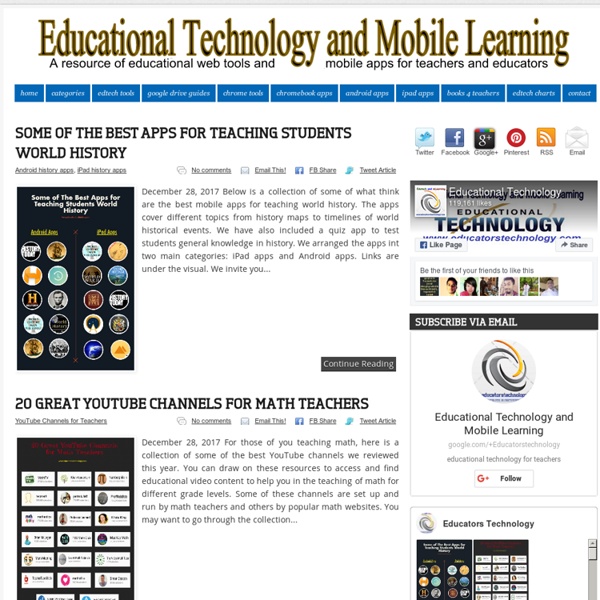



http://www.educatorstechnology.com/
Related: Teacher tools 2.0 • Tecnologia & didattica • Professional Learning • Nice sites & blogs • new technologyThe Teacher's Guides To Technology And Learning Welcome to the official guide to technology and learning by Edudemic! This part of Edudemic is meant to offer you, the teacher, some of the best and most popular resources available today. We’ve combed through hundreds of resources in order to narrow down our guides into something easy to read, easy to use, and easy to share. Below are links to the guides we have made so far. They’re always a work in progress so be sure to let us know if we missed something or if you have more resources you want us to call out in the guides. Learning Twigs The idea of disintermediation ("cutting out the middle man") in terms of professional qualifications has been slowly but surely gathering steam in a variety of fields. Take a look at a range of Position Descriptions for new jobs these days and phrases along the lines of Tertiary qualifications in a relevant discipline, or equivalent experience and expertise/skills are becoming more frequent. Private companies (as we might expect) have been quicker to apply this in practice rather than rhetoric compared to educational institutions, mired as most of them are in conservative paper-reliant processes for verifying applicants' skills, but even here we are starting to see change.
25 Of The Best Pinterest Boards In Education Blogs and Twitter aren’t the only social tools out there that can help you keep up with the latest and greatest developments in educational technology. Pinterest is rapidly becoming a favorite tool of educators all over the nation, and many have amassed some pretty great collections of edtech-related pins that teachers and students alike can use to explore new ways to learn, share, teach, and grow. While it would be nearly impossible to highlight every edtech pinboard out there, we’ve shared some of the boards we think stand out among the crowd here.
Tired of Teaching “Elements of Plot”? A New, Fun Approach! Are you tired of beginning each school year with the same ol’ “Elements of Plot” lesson? The initial vocabulary and concepts related to “Plot” can be kind of “dry” and “boring”, especially if you’re a student in grades 7th-10th! You know what I’m talking about because we’ve all been there ;) The Elementary Entourage: Technology Tips & Tricks: Do you Symbaloo? Hello friends! It's Kim here from For a Love of Teaching to introduce you to one of my favorite technology organizing tools! Have you heard of Symbaloo? Do you have websites bookmarked here, there, and everywhere? Do you have amazing websites you've found over time to use in your classroom or with your students, but can never find them when you need them?
100 Ways To Use Twitter In Education, By Degree Of Difficulty Twitter may have started off as a fun social media site for keeping up with friends and sharing updates about daily life, but it’s become much more than that for many users over the past few years as the site has evolved and grown. These days, Twitter is a powerhouse for marketing, communication, business, and even education, letting people from around the world work together, share ideas, and gain exposure. It has become a staple at many online colleges and campuses as well, leaving many academics wondering just how and if they should be using Twitter both in the classroom and in their professional lives. Code Maven and Game Maven Teach Kids to Program Their Own Games Code Maven and Game Maven are interactive programming tutorials from Crunchzilla. Code Maven and Game Maven use the same style as the popular Code Monster javascript programming tutorial. That style is to present a piece of code with instructions on one side of the screen while providing a visual of the outcome on the other side of the screen. Code Maven offers 59 lessons for students to work through at their own pace to learn programming fundamentals. After completing the Code Maven tutorials students are ready to move on to Game Maven where they can work through 37 lessons in which they will create three simple online games.
Langwitches I have been a fan of Visible Thinking Routines which were developed by Project Zero from Havard, for a while now. I have used these routines with students, as blogging routines and in professional development workshops. The Visible Thinking Routines website explains that: Routines exist in all classrooms; they are the patterns by which we operate and go about the job of learning and working together in a classroom environment. A routine can be thought of as any procedure, process, or pattern of action that is used repeatedly to manage and facilitate the accomplishment of specific goals or tasks.[…] Classrooms also have routines that structure the way students go about the process of learning As I am trying to make 21st century, modern, contemporary or “now” learning visible, it seemed a natural step to point out “Modern” or “Now” Learning Routines.
I find this pearl interesting. It shares different learning tools that educators can easily use to facilitate learning. It present visuals, audio, of various qualities. Teachers could make a choice of books, docoments, folders, videos etc. This gives opportunities for the integration of technology in learning, and at the same time facilitate usage because of the mobile nature of some of them. by roselinendifor Apr 11